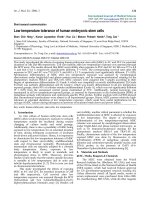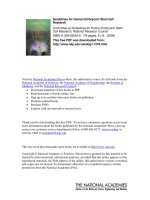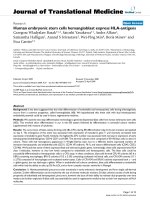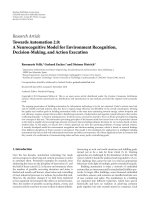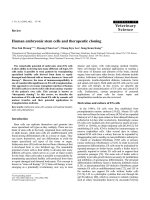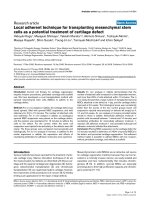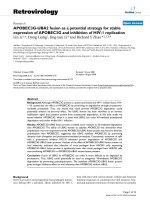Human embryonic stem cells as a cellular model for osteogenesis in implant testing and drug discovery
Bạn đang xem bản rút gọn của tài liệu. Xem và tải ngay bản đầy đủ của tài liệu tại đây (2.01 MB, 117 trang )
HUMAN EMBRYONIC STEM CELLS AS A CELLULAR
MODEL FOR OSTEOGENESIS
IN IMPLANT TESTING AND DRUG DISCOVERY
LI MINGMING
NATIONAL UNIVERSITY OF SINGAPORE
2010
HUMAN EMBRYONIC STEM CELLS AS A CELLULAR
MODEL FOR OSTEOGENESIS
IN IMPLANT TESTING AND DRUG DISCOVERY
LI MINGMING
(B.Sci), NUS
A THESIS SUBMITTED FOR THE DEGREE OF
MASTER OF SCIENCE
DEPARTMENT OF ORAL & MAXILLO-FACIAL SURGERY
FACULTY OF DENTISTRY
NATIONAL UNIVERSITY OF SINGAPORE
2010
Acknowledgement
First, I would like to express my sincere gratitude to my supervisor associate Prof.
Cao Tong who guided me through the master’s program. He allows me to think
independently and is always there to listen and give advice. He taught me how to
ask scientific questions and interpret data to answer those questions. His generous
support, continuous guidance encouraged me to be confident in me when I
doubted myself. Without him, I could not have finished the whole program.
In addition, I would like to thank my very friendly colleagues in stem cell
laboratory, Dr LiuHua, Dr YangZheng, Mr Toh WeiSeong, Mr LuKai and Ms
FuXin for their invaluable suggestions and unconditional help. Besides them, I
also appreciate Mr Chan Swee Heng, Ms Angelin Han Tok Lin, and Ms Liu
YuanYuan for their support in allowing me to use their equipments.
Also, I would like to thank Miss Cynthia Sing Siuh Eng, et. al from the Dean’s
office for their administrative support. Especially, I would like to give my thanks
to Faculty of Dentistry for providing me the research scholarship for the whole
master’s program.
i
Table of contents
Acknowledgement……………………………………………………………….i
Table of contents………………………………………………………………..ii
Abstract………………………………………………………….……………viii
List of Figures……………………………………………………………………x
Chapter I literature review…………………………….………….1
1.1 Tissue engineering…………………………………………………………..2
1.1.1 Material of implants
1.1.2 Biocompatibility
1.2 Stem cells…………………………………………………………………….4
1.2.1 Significance in the use of stem cells
1.2.2 Definition of stem cells
1.2.2.1 Adult stem cells
1.2.2.2 Embryonic stem cells
1.2.2.3 Induced pluripotent stem (iPS) cells
ii
Chapter II Culture and Propagation of H9 hESCs…….………17
2.1 Material and methods……………………………………………………..18
2.1.1 Culture of H9 hESCs
2.1.2 Embryoid body (EB) formation
2.1.3 Pluripotency of H9 hESCs
2.1.4 Polymerase chain reactions for pluripotent markers
2.1.5 Immunocytochemical staining for pluripotent markers
2.1.6 Teratoma formation and staining for three germ layers
2.2 Results…………………………………………….………………………….22
2.2.1 Characterization of undifferentiated H9 hESCs
2.2.2 EB formation and Teratoma formation
Chapter III hESCs as a cell model for small molecule induced
differentiation…………………………………………………………
28
3.1
Introduction…………………………………………………….……………….29
iii
3.1.1 Osteogenesis from hESCs
3.1.2 Why small molecule purmorphamine?
3.1.3 Physical properties of purmorphamine
3.2 Material and methods……………………………………………………..33
3.2.1 Cyto-toxicity testing of purmorphamine through MTS assay
3.2.2 Purmorphamine on H9 hESCs attachment
3.2.3 Osteogenesis using H9 hESCs with prumorphamine treatment
3.2.4 Characterization of osteogensis
3.2.4.1 Alizarin red staining
3.2.4.2 Polymerase chain reaction
3.2.4.3 Total cellular protein concentration
3.2.4.4 Alkaline phosphatase secretion assay
3.2.4.5 Osteocalcin secretion assay
3.2.4.6 Purmorphamine on cell growth and viability test
3.2.4.7 Statistical analysis
3.3 Results……………………………...………………………………………41
3.3.1 Cytotoxicity testing of purmorphamine
iv
3.3.2 Purmorphamine effects on H9 hESCs attachment
3.3.3 Purmorphamine induced differentiation of H9 hESCs
3.3.4 Production of bone nodules
3.3.5 Purmorphamine effects on cell growth during differentiation
3.3.6 Characterization of osteoprogenitors
Chapter IV In Vitro biocompatibility testing of 3DP titanium
implants………………………………………………......…………57
4.1 Introduction…………………………………………………….………….58
4.2 Material and methods for cytotoxicity testing…………………….……..60
4.2.1 Sterilization of testing materials
4.2.2 Cell culture
4.2.3 Cell attachment tests using hFOB
4.2.3.1 FDA staining to examine cells on implants
4.2.3.2 Collagen I staining to examine the matrix secretion
4.2.3.3 Data analysis
4.3 Results………………………….…………………………………………65
v
4.3.1 Cytotoxicity of titanium implant
4.3.2 Cell attachment test of the implant
4.3.3 Cell migration, proliferation in the implant
4.3.4 Cell function in the implant
Chapter V Osteogenic differentiation of hESCs as a model in 3D
implants testing……………………………………………..…….76
5.1 Inctroduction…………………………………………...………………….77
5.2 Material and methods…………………………………………………….77
5.2.1 Cell seeding
5.2.2 Cell growth in the 3D implant
5.2.4 AP secretion assay
5.2.4 Osteocalcin secretion assay:
5.2.5 Collagen I staining to view the matrix secretion:
5.2.6 Data analysis
5.3 Results………………………………………………………...……………80
5.3.1 Growth of hESCs and subsequent derivatives in implants:
vi
5.3.2 Characterization of H9 hESCs on osteogenesis:
Chapter VI Discussion…………………...……………………….91
Chapter VII References………………………………………….99
vii
Summary
Human embryonic stem cells (hESCs) hold great promises in many aspects of
research and clinical usage. Comparing with other type of stem cells such as adult
stem cells and induced pluri-potent stem cells (iPSCs), hESCs are unique with
many advantages such as their pluripotency, capable of unlimited self-renewal
with intact chromosomal integrity. In daily life, we are subjected to bone injuries
and illnesses which our bodies are unable to recover by themselves. The
emergence of tissue engineering and cell therapy in the past decades has shown
some progress in both research and clinical practice. However, the exploration of
hESCs in such applications is still far early from practice. This study aims to open
the horizon for the use of hESCs as a cellular model for implant testing and drug
discovery along its differentiation process toward osteogenic lineage. Most of the
current implant testing relies on adult stem cell (Mesenchymal stem cells, etc.)
and primary cells from human tissue. However, the main disadvantage of using
such cells is, they produce large variations from batch to batch. hESCs and their
derivatives are special groups of cells like other cells from our body, and able to
be passaged for long term testing with minimal variations. Here, we first studied
the possibility of using hESCs as a model for drug discovery in osteoblast lineage
generation. Conventional osteoblast lineage differentiation from hESCs depends
purely on cock-tail supplements (Dexamethason, β -glyceralphosphate and
ascorbic acid). In our studies, in addition to the cock-tail supplements, we found
that a small molecule purmorphamine was able to enhance the osteogenic
viii
potential of hESCs greatly, which demonstrates that hESCs can be used as a
model for drug discovery along their differentiation process. Also, we explored the
use of hESCs and their derivatives as a model for implant testing. Conventional
testing of medically used implants involves the use of immortalized cell lines.
Though the testing results are consistent, those cell lines are not able to represent
human physiology fully because lack of chromosomal integrity. hESCs and their
derivatives are genetically untouched cells and able to be passaged without limit.
Use of hESCs and derivatives for implant testing not only helps us to examine
how normal human cells respond to the implant, but also helps us to understand
development of osteoblast cells that constitute the bone and their function. In sum,
either as a model for drug discovery or implant testing, hESCs are able to perform
as well or even better than the cell lines used for majority of the studies.
ix
List of figures
Chapter II
Figure 2.1. H9 hESCs colonies and staining results on pluripotency.
Figure 2.2 Embryoid bodies after 3 and 5 days’ growth.
Figure 2.3 PCR results for Oct4 and Nanog for 3 different samples.
Figure 2.4 Histological staining for teratomas formation after 7 weeks of
implantation.
Chapter III
Figure 3.1 Purmorphamine induced osteogenic differentiation with time point
study in comparison with no treatment.
Figure 3.2 Cytotoxicity of purmorphamine on hFOB, HEPM and H9 ebF.
Figure 3.3 Purmophamine treatments for cell attachment of H9 hESCs.
Figure 3.4 Morphological pictures of differentiated H9 cells.
Figure 3.5 Expression of pluripotency, osteolineage, chondrogenic lineage, and
adipogenic lineage markers for 20 samples under different inducing media.
Figure 3.6 Alizarin red staining for differentiation under base/cock-tail medium.
Figure 3.7 Cell growth profile during differentiation in base medium.
Figure3.8 OC level in differentiated cell lysate at day 21.
Figure3.9 Alkaline phosphate level in cell lysates at day 21.
Figure3.10 AP secretion tendency in media spent along the time course of
x
differentiation.
Figure3.11 AP activity in media spent at day 20.
Chapter IV
Figure 4.1 placement of testing materials
Figure4.2 Cell morphology around the testing materials.
Figure4.3 Dose response curve on cytotoxicity of phenol on cell viability.
Figure4.4 Cell viability in testing groups
Figure4.5. Cell seeding figure with/without hydrogel embedding
Figure4.6 Percentage of cells attachment with/without hydrogel embedding.
Figure 4.7 Microscopy pictures of FDA and PI staining
Figure4.8. Collagen I (red) and FDA (green) co-staining for the 3DP implant 2
weeks after differentiation.
Chapter V
Figure 5.1 Cell growth profile on implant for different seeding groups.
Figure 5.2 Collagen I and FDA co-staining for differentiated cells on implants
after 21 days of treatment in cocktail differentiation media.
Figure 5.3 AP activity in media spent along the time course of differentiation.
Figure 5.4 OC secretion level along the time course of differentiation.
xi
Chapter I
Literature review
1
Our bodies are subjected to injury and malfunctions from a variety of sources every
day. They are constantly repairing themselves to ensure our long-term survival.
However, certain damages are beyond our bodies repair capability and need
immediate treatment to protect them from further damages. Some times, medical
implants shall be transplanted to replace the missing biological structure or support
proper function of adjacent tissues. Expectations are high for treatment of such
damage and disorders. However, medical and surgical therapies are always either
ineffective or impractical. The emergence of tissue engineering has shown certain
progress regarding this historical condition.
1.1 Tissue engineering:
The term of tissue engineering has been used very frequently since its emergence in
1988. It is the use of a combination of cells, engineering and materials, with certain
biochemical factors to mimic biological functions in tissue failure or malfunction. In
practice, it has a broad range of applications such as repair or replace portions of or
whole tissues such as bone, cartilage, blood vessels even the heart valve with artificial
implants[1].
1.1.1 Materials of implants:
Many types of materials are currently used in clinical applications and commercially
2
available, such as ceramics, composite materials, metal alloys, bio-absorbable
materials, silicone, etc. Most of these materials share similar physical
properties---strength, resistance to abrasion and corrosions. In our daily activities, we
place high levels of mechanical stress on our body especially on our bones and joints.
The implant must be able to withstand these stresses day to day without breaking or
changing its shape. While strength of the implants is important, it must also be
resistance to abrasions. Frictions on the implant may create particles that cause
inflammation of surrounding tissues. In the long run, implant materials are subject to
corrosion from our body fluids creating particles similar to abrasion. Severe
weakening of the implants may ultimately cause failure of transplantation or damage
of surrounding tissue. Despite of these physical properties, biocompatibility testing
ensures safe transplantation of the implants.
1.1.2 Biocompatibility
Biocompatibility refers to the way materials interact with our body. It is related to the
behavior of biomaterials in several contexts. Firstly, implant material should not elicit
any toxicity or injurious effects on biological hosts. Some materials, lead and mercury
for example, are naturally harmful when taken into the body, so are not suitable for
implanting. Also, it should not trigger any immunological reactions after
transplantation. More importantly, it should have the ability to perform its desired
function with respect to a medical therapy which should be beneficial to the host,
3
such as generating appropriate cellular or tissue response to optimize its performance.
Majority tests of biocompatibility for implant materials were done in the in vitro
environment on immortalized cell lines in accordance with ISO10993 (or similar
standards)[2]. Such tests do not determine the biocompatibility of materials to host,
but they constitute an important step towards the in vivo animal tests and future
clinical applications. Up to date, most of biocompatibility tests are performed using
commercially immortalized cell lines. However, such cell lines are either from animal
origin or genetically modified human cells. Strictly speaking, majority of the cell
lines used currently cannot resemble human physiology fully. Hence, exploring a
stable standard cell line that best reflects human physiology is in need. In this book,
we explore the possibility of using human embryonic stem cells and derivatives as
cellular model in implant testing for two main reasons. One, human embryonic stem
cells are the very original cells that our human body is developed from, it best reflects
human physiology than any other cells lines. Secondly, stable cell lines can be
derived from hESCs when giving specific stimuli. Such differentiation process is not
only meant to obtain stable cell lines that resembles human physiology best, but also
enables us to explore the specific drugs for human development and diseases.
1.2 Stem cells:
Often, the tissue involved in replacement not only requires the mechanical and
structural support from implants, but has also the efforts to perform specific
4
biochemical or physiological functions involving in embedding cells in the artificial
implants. Hence, regenerative medicine is always used synonymously with the term
tissue engineering, although regenerative medicine emphases more on the use of stem
cells. In addition to biomaterial implants and factors inducing stem cell differentiation
towards specific lineages, the emerging field of regenerative medicine requires a
reliable source of stem cells[3]. Up to date, Stem cells are still of great scientific,
social and political interest in this new millennium primarily because of their function
in replenishing specialized somatic cells and maintaining normal turnover of
regenerative organs such as blood, skin and intestinal tissues.
1.2.1 Significance in the use of stem cells:
Through research into human growth and cell development, stem cells provide
medical benefits in fields such as therapeutic cloning and regenerative medicine. With
the great potential for discovering new treatments and cures to disease including
Parkinson‘s disease, schizophrenia, Alzheimer‘s disease, Cancer, spinal cord injuries,
diabetes and many more, stem cells may also materialized the hope of growing limbs
and organs in laboratory for transplantation in future. Currently, stem cells can be
used in testing millions of potential drugs and medicine without the use of animals or
human volunteers. Comparing with immortal cell lines and animal models, stem cell
reflects the best human physiology. When used for drug testing, stem cell or its
derivatives are able to reveal whether the drug is useful to restore physiological
5
function or elicit any side effect to a specific lineage of cells in our body. Stem cell
research also benefits the study of development stages that cannot be studied directly
in human embryo providing mechanisms, preventions and cures for birth defects,
pregnancy loss and infertility. Through stem cell research, scientists has already
found out the reason for aging and provided many treatments to help slow the aging
process[4], with further researches done, more mechanisms will be unveiled and
aging would possibly be reversed to prolong our lives.
1.2.2 Definition of stem cells:
Stem cells are found in most multi-cellular organisms. They can be isolated or
derived from the embryo, fetus or adult that has, under certain conditions, posses the
ability of self renewal for long period of time by mitotic division. They are
unspecialized cells, but can give rise to specialized cells that make up tissues and
organs in the body. By conventional categorization, there are mainly two types of
stem cells, adult stem cells (also named as somatic stem cells), and embryonic stem
cells[5]. However, a third type of pluripotent cell was introduced in 2007 through
genetic manipulation of somatic cells. With the successful retroviral transduction of 3
or 4 transcriptional factors, mouse and human somatic cells can be reprogrammed to
a pluripotent state similar to embryonic stem cells, which was subsequently named as
induced pluripotent stem (iPS) cells[6-7].
6
1.2.2.1 Adult stem cells
The term adult stem cell refers uncommitted cell that is found in a differentiated
(specialized) tissue that has two basic properties: the ability of self-renewal and
differentiate to yield the major specialized cell types of the tissue or organ it
originated from[5].
Each tissue and organ in our body is made up of cells with specialized functions and a
finite life span. For example, a neuron specialized in the conduction of electrical
impulses; a hepatocyte specialized in detoxifying our bodies; a cardiomyocyte is
specialized in contractions that generate our heartbeats. In case of specialized cell
death or under conditions such as tissue damage, stem cells in our body play the key
role in replenishing such cells.
Study of adult stem cells can trace back in the early 1960, when Joseph Altman and
Gopal Das discovered neurogenesis in guinea-pig[8], which is the first scientific
discovery in the creation of adult neurons in adult brain, suggesting ongoing stem cell
activity in adults. Later in 1963, McCulloch and Till illustrated the presence of
self-renewing cells in mouse bone marrow through colony formation rising from a
single cell [9-10]. Still, their work did not draw much attention on the regenerative
properties of stem cells until in 1968, after a successful transplantation of bone
marrow between two siblings to treat Severe Combined Immunodeficiency (SCID).
7
Ten years after scientists realized the great potential of stem cells in medical
treatments and therapy, in 1978, the very first hematopoietic stem cell was discovered
in cord blood giving rise to possible treatments for certain blood and immune diseases
such as leukemia and anemia[11].
Over half a century‘s excitement research on adult stem cells, many types of stem
cells were found in many more tissues than once thought possible. From the very first
discovery of hematopoietic stem cells in born marrow, mesenchymal stem cells (MSC)
have been isolated from placenta, adipose tissue, lung, bone marrow and blood[12].
Neural stem cells have been isolated and cultured in vitro as neurosphere[13].
Olfactory adult stem cells have been isolated from olfactory mucosa [14]. Mammary
stem cells have been isolated from mammary gland [15-16]. Adipose-derived stem
ADS) cells from human adipose tissue [17]. Stem cells from dental pulp have been
found to have same cellular markers and differentiation abilities of mesenchymal
stem cells [18]. Given the right condition, some of these stem cells can differentiate
into a number of specialized cell types, for example, MSC and ADS can differentiate
into osteo-lineage, adipo-lineage and chondro-lineage cells. With optimal control of
in vitro differentiation, these cells may result in tremendous benefits for many
patients with serious diseases.
With the exciting hope of adult stem cell therapies, there are still problems holds great
concerns from scientists, clinicians and patients. Adult stem cells are rare in mature
8
tissues and methods for expanding their numbers in culture have not yet been worked
out, which are the primary difficulties in using adult stem cells for regenerative
medicine practically. Cell therapy using adult stem cells should meet the following
criteria as well. Cells should be easily extracted with minimally invasive procedures
from host. They should be able to differentiate into multiple lineages in a
reproducible manner with proper regulations. They should be transplanted into
autologous or allogeneic host safely and effectively[19].
In earlier this year, donor derived brain tumor after neural stem cell transplantation
for ataxia telangiectasia was reported [20]. This report reemphasized another
important problem of stem cells studies, which is the characterization of stem cells
should be thoroughly studies to avoid Graft-Versus-Tumor effect. It has been reported
that adipose derived stem cells undergo malignant transformation after more than 4
month passaging even in in vitro studies [21]. Currently, there is still lack of a
universal standard for the nomenclature and characterization of adult stem cells. For
example, adipose derived stem cells share similar surface markers expression profiles
with bone marrow derived mesenchymal stem cells and able to differentiate into same
mesoderm lineages[22-23]. This might be an extension of current technical problems
in obtaining pure, uniform sample of adult stem cells. Such difficulty challenge
scientists on drawing conclusions on the consistency of their experiments. As
discussed above, the problems we face today, may severely limit the use of adult stem
cells either in research or clinical applications.
9
1.2.2.2 Embryonic stem cells:
Another type of stem cells by conventional categorization is embryonic stem cells
based on its origin from the fertilized egg. In 1981, embryonic stem cells (ESC) were
first isolated and derived from mouse embryos by Martin Evans and Matthew
Kaufman from University of Cambridge and Gail R. Martin from University of
California [24-25]. Briefly, ESCs were derived from inner cell mass of 3 to 5 days
embryo named as blastocyst. They established culture conditions for growing
pluripotent mouse ESC in vitro. The ESCs posses normal diploid karyotypes and able
to generate derivatives of all three germ layers. Injecting the ESCs into mice induced
the formation of teratomas. 17 yeas after the first derivation of mouse ESCs, a
breakthrough occurred when Thomson et. al derived the very first line of human
ESCs from the inner cell mass of normal human blastocysts. The cells are cultured
through many passages until today and distributed around the globe. The hESCs still
retain their normal karyotypes and high levels of telomerase activity. When injected
into immuno-deficient mouse, teratomas were formed including cell types from all
three germ layers [26].
When given no stimuli for differentiation, ESCs maintain pluripotency through
multiple cell divisions. Because of their pluripotency and potentially infinite
competence of self-renewal, ESCs hold great promises in many research areas and
applications. Study of embryonic stem cells helps us to unveil secrets of human
10
development. hESCs can be used to identify drug targets and test potential
therapeutics. They can also be used for toxicity testing. Also, studying hESCs help us
to understand prevention and treatment of birth defects. More importantly, studying
hESCs differentiation towards somatic lineages proposed enormous therapeutic
potential for regenerative medicine and tissue replacement after injury or disease.
After the very first isolation and derivation, intensive hESCs researches are
conducted to look for better ways to harness the potential of stem cells for possible
medical treatment and therapies. Below are some of the remarkable achievements in
the past decade:
Establishing long term viability of human embryonic stem cells in a feeder-free
system[27].
Differentiation of hESCs in 3-D polymer implants for specific shapes [28].
hESCs derivatives facilitate motor recovery of rats to restore movements from
paralysis[29].
Establishing human feeder layers supporting prolonged expansion of hESC
culture[30].
Achieved homologous recombination in hESCs[31].
hESCs derivative may help to treat vision loss[32].
Large scale culture method to produce blood cells from hESCs[33].
hESCs derivative cure mouse model of hemophilia[34].
11
